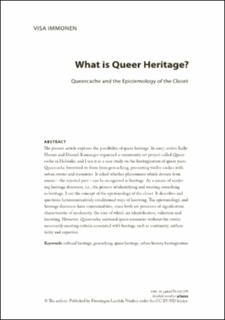What is Queer Heritage? Queercache and the Epistemology of the Closet
Journal article, Peer reviewed
Published version

Åpne
Permanent lenke
https://hdl.handle.net/11250/3017219Utgivelsesdato
2022Metadata
Vis full innførselSamlinger
Originalversjon
Lambda Nordica: Tidskrift om homosexualitet. 2022, 27 (2), 41-68. https://doi.org/10.34041/ln.v27.788Sammendrag
The present article explores the possibility of queer heritage. In 2017, artists Kalle Hamm and Dzamil Kamanger organised a community art project called Queercache in Helsinki, and I use it as a case study on the heritagisation of queer pasts. Queercache borrowed its form from geocaching, presenting twelve caches with urban stories and memories. It asked whether phenomena which deviate from norms – the rejected past – can be recognised as heritage. As a means of analysing heritage discourse, i.e., the process of identifying and treating something as heritage, I use the concept of the epistemology of the closet. It describes and questions heteronormatively conditioned ways of knowing. The epistemology, and heritage discourse have commonalities, since both are processes of signification characteristic of modernity, the core of which are identification, valuation and knowing. However, Queercache nurtured queer memories without the stories necessarily meeting criteria associated with heritage such as continuity, authenticity and expertise.
